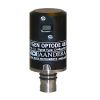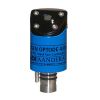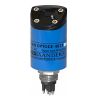Aanderaa 4531 Oxygen Optode Sensors
Features
- Optical lifetime-based luminescence quenching measurement principle
- Long time stability with red reference LED
- Available with integrated cable or wet-mate connector termination
- Expedited repair and warranty service
- Lifetime technical support
- More
Overview
The Aanderaa Oxygen Optodes are based on the ability of selected substances to act as dynamic fluorescence quenchers. The fluorescent indicator is a special platinum porphyrin complex embedded in a gas-permeable foil that is exposed to the surrounding water. The sensor has an incorporated temperature thermistor, which enables linearization and temperature compensation of the phase measurements to provide the absolute O2 concentration.
Mechanics
A black optical isolation coating protects the complex from sunlight and fluorescent particles in the water. This sensing foil is mounted on a glass window, providing optical sampling from inside a watertight housing. The sensing foil is excited by modulated blue light; the sensor measures the phase of the returned red light. For improved stability, the optode also performs a reference phase reading using a red LED that does not produce fluorescence in the foil.
Ranges
The Oxygen Optode outputs data in RS-232 and analog 0-5V, 0-10V or 4-20mA. The sensor can present the O2 concentration in µM, Air Saturation in % and Temperature in °C.
In The News
Wildfire Prevention in the Sierra Nevada Region with the Yuba Watershed Institute
Though recent wildfires have sparked new conversations about wildfire management and response, groups like the Yuba Watershed Institute have been monitoring the forests and water resources of the Sierra Nevada region for decades, managing approximately 5,000 acres of land with the Bureau of Land Management (BLM) and about 7,000 acres in private land partnerships. The goal of the Institute is to work with local communities and land agencies to improve watershed and forestry management through informed practices and public outreach. The goals of the Yuba Watershed Institute are three-fold: Improve the ability of fire suppression agencies like the California Department of Forestry and Fire Protection ( CAL FIRE ) and the US Forest Service.
Read MoreWave Sensors Integration with NexSens Buoys: A Cutting-Edge Solution for Wave Measurment
Real-time wave data supports accurate weather prediction, safe and efficient maritime operations, and provides valuable safety and operating condition information for recreation and commercial fishing. Understanding wave dynamics also helps with the design of protective coastal structures like seawalls, breakwaters, and jetties. It also supports better prediction of their impact on sediment transport and coastal geomorphology. Wave data is a key factor in qualifying and designing offshore wind farms and harnessing kinetic energy for electrical generation. It helps with the understanding of ocean-atmosphere interactions and contributes to studies of sea-level rise and climate change impacts.
Read MoreSpring 2025 Environmental Monitor Available Now
In the Spring 2025 edition of the Environmental Monitor, we highlight partnerships across the world and the importance of collaboration between government agencies, universities, environmental groups, local communities, and other stakeholders. From great white shark research in Cape Cod to monitoring fisheries in Lake Erie, this latest edition underscores partnerships that connect stakeholders in a watershed through environmental data. With an emphasis on data sharing, a combination of real-time and discrete sampling keeps the public and partners informed of environmental conditions. Our writers also sought out science professionals dedicated to working with peers within and outside of the environmental sector.
Read More














